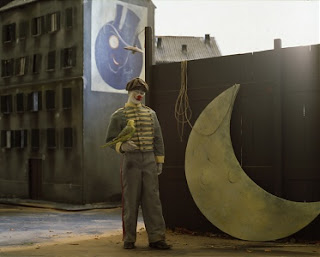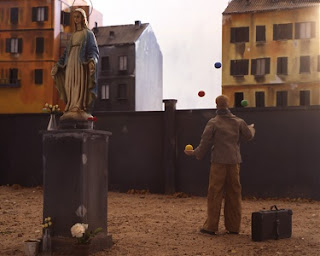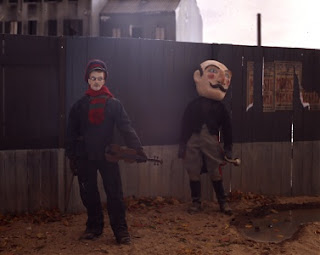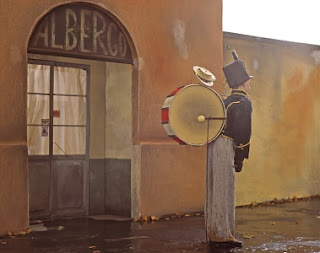The Sunday review, with milk-lashed coffee.
In the air and in my ear: Maria Schneider Orchestra, then Hiromi Uehara... followed by Macy Gray, and now the North Mississippi Allstars...
David Brin worries that the search for extraterrestial life might be the equivalent of yelling "yoo hoo" in a dark forest, thereby drawing in the predators... click here for more.
Mark Anthony Neal interviews Sofia Quintero (aka Black Artemis, co-founder of Chica Luna Productions)-- click here.
Jai Arjun Singh provides good insight into Syed Muhammad Ashraf's The Beast, a 1997 novella recently translated into English by Musharraf Ali Farooqi. Click here, and go to Singh's Feb. 17 posting.
Finally, the lobster and the canary bow their heads (but lift up their hearts!) in memory of the poet Lucille Clifton, who died February 13th in Baltimore, aged 73. We will miss her voice, so direct, so compassionate, able to draw down and expose meaning in the most humble and daily of details.
Elizabeth Alexander's salute to Clifton (in The New Yorker online, Feb. 17th) is particularly fine: click here.
Sunday, February 28, 2010
Saturday, February 27, 2010
N.K. Jemisin's The Hundred Thousand Kingdoms
Nora K. Jemisin : Orbit published her first novel, The Hundred Thousand Kingdoms, this past week.
The launch party Thursday evening in Soho, NYC was wonderful. Despite slush, snow and sleet, the room was packed. Spotted: Ellen Kushner, Alaya Dawn Johnson, Matt Kressel, Tempest Bradford, Delia Sherman, Ellen Datlow.
Congratulations Nora! The lobster and the canary hope to interview Nora soon.
The launch party Thursday evening in Soho, NYC was wonderful. Despite slush, snow and sleet, the room was packed. Spotted: Ellen Kushner, Alaya Dawn Johnson, Matt Kressel, Tempest Bradford, Delia Sherman, Ellen Datlow.
Congratulations Nora! The lobster and the canary hope to interview Nora soon.
Wednesday, February 24, 2010
Monday, February 22, 2010
Don't read this blog! Read a novel instead!
From "The Future of Reading" by Josh Quittner in Fortune (March 1, 2010, pg. 66):
"People definitely want to browse. ... But many also crave deep reading experiences. Man does not live by blog alone! It would be like surviving entirely on cupcakes."
Well said! The lobster urges you, gentle reader, to delve into a novel this evening, once you quit our blog for today.
"People definitely want to browse. ... But many also crave deep reading experiences. Man does not live by blog alone! It would be like surviving entirely on cupcakes."
Well said! The lobster urges you, gentle reader, to delve into a novel this evening, once you quit our blog for today.
Sunday, February 21, 2010
Sunday Morning: Coffee, The World's Largest Book, and Blogs

[Photo from The Guardian.co.uk, article by Mark Brown, January 26, 2010]
Sunday morning, snow on the ground but a hint of spring in the blue air.
Coffee with brown sugar and a dash of grated nutmeg.
Jean-Luc Ponty and Tangerine Dream on the airwaves.
The world's largest book goes on display at the British Museum in April: the Klencke Atlas, given by Dutch merchant Johannes Klencke to Charles II at the Restoration in 1660.
I want to walk into this book, lose myself in the lands it depicts.
I wonder if we'd find Uqbar somewhere in its massive pages?
While imagining that, check out the February issue of Bookslut. Elizabeth Bachner has an excellent piece on Dubravka Ugresic's Baba Yaga Laid an Egg (Ugresic is also featured in the current issue of Bookforum-- this novel goes on the lobster's tbr list).
Also in Bookslut this month-- a good interview of Maryse Conde by Megan Doll.
Conde on the truth of story: "You know, people will tell you that in places like the Caribbean, West Africa and so on, we have two distinct elements. We have history which is written in books about the white people -- how they came to Guadeloupe, how they colonized Guadeloupe, how they became the masters of Guadeloupe -- and you have memory, which is the actual facts of the people of Guadeloupe and Martinique -- the way they lived, the way they suffered, the way they enjoyed life. We are trained to rely more on our memories and the memories of people around us than on books."
The Quarterly Conversation has many good things (as always). My favorite this go-round is Tony Miksanek's review of Selected Prose of Heinrich von Kleist (trans., with afterword, by Peter Wortsman; Archipelago Books). Miksanek: "In the hands of von Kleist, paradox and dramatic irony are not literary devices but rather fundamental features of ordinary life."
At Cabinet des Fees, Erzebet YellowBoy reviews Ali Shaw's The Girl with Glass Feet.
*Canary hops from one foot to the other-- another book for the tbr list-- let us petition the sun for just twenty extra minutes a day*
Saturday, February 20, 2010
Nebula Award Nominees Announced
The Science Fiction & Fantasy Writers of America has released the nominees for the Nebula Awards.
Click here for the list of nominees.
The nominees for best novel are particularly strong.
Click here for the list of nominees.
The nominees for best novel are particularly strong.
Thursday, February 18, 2010
Tanguy and the Indefinitely Divided
Monday, February 15, 2010
Eleanor Wilner on the Past
A thought from poet Eleanor Wilner that I have been mulling for several years:
"As we change the past, so we are changed."
(From her late 1990s essay, "Playing the Changes," for which I need of course a more precise citation-- I am not sure from whence it fetched up in my commonplace book.)
A truism...but much more than that, as Wilner explores the nature of history, change, historicity.
Which drives at the heart of narrative, storytelling, the coming-at of the truth of things.
Reminds me of the work of Reinhart Koselleck, Hayden White, Roger Chartier and other historians who have sought the origins of historical phenomena in terms of rhetorical strategy.
Borges's "Circular Ruins." The Sun Stone by Paz.
Battlestar Galactica.
"As we change the past, so we are changed."
(From her late 1990s essay, "Playing the Changes," for which I need of course a more precise citation-- I am not sure from whence it fetched up in my commonplace book.)
A truism...but much more than that, as Wilner explores the nature of history, change, historicity.
Which drives at the heart of narrative, storytelling, the coming-at of the truth of things.
Reminds me of the work of Reinhart Koselleck, Hayden White, Roger Chartier and other historians who have sought the origins of historical phenomena in terms of rhetorical strategy.
Borges's "Circular Ruins." The Sun Stone by Paz.
Battlestar Galactica.
Sunday, February 14, 2010
Sunday Morning: Coffee, "My Funny Valentine," and Blogs

Coffee, with lots of hot milk, frothy.
Cold outside, very cold. Gulls skimming the Hudson, Brant Geese seeking shelter by the ferry landing.
"My Funny Valentine" -- the Miles Davis version.
And time to catch up on what others are saying. To savor and digest.
Three whose separate musings constantly inspire: Kate Castelli's Wandering But Not Lost,Sonya Taaffe's Myth Happens, and Leigh Batnick's Jezebel, Correspondence for the Vagabond Heart. Reading their daily entries is like reading Stefan Zweig or Borges, receiving a letter from Virginia Woolf or Marianne Moore, scanning the sketchbooks of Klee or Matisse.
Above is "A Field Guide to Airships," Castelli's February 4th entry--inspired by Italo Calvino's Invisible Cities.
Picking a recent post at random from Myth Happens, the January 23rd on Macbeth ("your eyes were glacial and your promises all rang true"): "The world of Macbeth is one of witches and worse things waiting, curses and prophesies and adynata that come, however slantwise—none of woman born, till Birnam wood remove to Dunsinane—true. (I'm with Tolkien, however, in being disappointed that the actual wood does not go anywhere. I really expected it to, the first time I read Macbeth. It's like an entire forest of Chekhov's gun.) It's not the most supernatural play in the canon, but it's got to be up there. Ghosts and apparitions are not suspensions of disbelief, but factual as branches or blades. And words are spells. Our chief guest, all-thing unbecoming, a most indissoluble tie, this is performative speech. So don't command someone to dinner and then kill him, for the love of little green apples. Especially in a Scotland of völur, you're a fool if you think a man's death is a stronger bond than his word."
Or, at Jezebel ("bookworms, gin drinkers, slip off your satin slippers...I've been waiting for you"), the February 12th entry on the death of Alexander McQueen: "A ghost in your world, before you became a ghost in ours. The angels will be more beautiful than ever - a dressmaker for the cosmos is in their midst."
Elegies also for two other recently departed: Cat Rambo's "Goodbye to Kage Baker," February 4th in Fantasy Magazine, and Ambling Along the Aqueduct's Feb. 9th "RIP Phil Klass" (a.k.a. William Tenn).
Gary K. Wolfe in the current Locus (paper version, pg. 16, not sure if this has been posted online yet) captures my feeling perfectly: "Like many, I was never particularly anxious to see [Peter S.] Beagle return to the world of The Last Unicorn, which is one of those books that seems such a pristine emblem of youthful reading and discovering the possibilities of fantasy, that it just shouldn't be messed with..."
Check out: "Nice Makes Write: An Interview with Casey Wolf," by Robert Runte, Feb. 8th in Strange Horizons; Sharon Butler's coverage of the discussions at the College Art Association's annual conference, Feb. 13th at her Two Coats of Paint; Laila Lalami's Feb. 12th note on Monique Truong's debut novel; and Jonathan Jones in The Guardian, Feb. 11th on Gorky and Rothko: "they aspired to greatness – a quality almost no art nowadays believes it can attain. Some people call them pompous for that; I call them courageous."
To round out the morning, a haunting poem by Mitchell Douglas, "Poem of the Week" right now at Cave Canem, entitled "Midnight Hour." It opens:
"He plays when dreams come, when
the hour is as late as the moon
allows, when
ribbons of light
slice window panes, shine
for the sake of sight."
Go re-fill your coffee mug, put some more Miles in your headspace, and read the rest of the poem.
Friday, February 12, 2010
KeKe Cribbs on play
Ceramicist KeKe Cribbs on play:
"Play is so important because it involves a willingness to fall down, make mistakes and learn from them."
(From Lynda McDaniel, "The Art of Play," in AmericanStyle, Winter 2009-2010.)
Click here for more.
"Play is so important because it involves a willingness to fall down, make mistakes and learn from them."
(From Lynda McDaniel, "The Art of Play," in AmericanStyle, Winter 2009-2010.)
Click here for more.
Wednesday, February 10, 2010
Adela Leibowitz: Luminous Dreamscapes


Adela Leibowitz is a painter you will hear much more about in the next few years. Her work is a portal into other worlds. The three examples above are all oil on linen, painted in 2008: Les fleurs du mal (Flowers of evil); Masque of the Red Death; History of Sin.
Click here for more about Adela.
Adela kindly answered a few questions for us.
Lobster & Canary 1. Reviewers frequently refer to the "dreamlike" quality of your work-- which I will echo. Do you find that a fitting descriptor, and, if so, why? Are your images taken from your dreams?
Adela: Dreamlike is a good description. The images aren’t taken from my dreams, but the moods or impressions that the dreams leave behind do make their way in.
2. Reviewers also note the "luminous" quality of your technique. Your use of color emerging (if the lobster can coin a phrase) reminds us a little of Turner, or of the French Impressionists. Do you paint studies for your finished pieces, playing with and adjusting the quality of the light? How do you know when you have hit just the right mood?
Adela: I guess some things just feel right, other times you just know when it’s not. Sometimes it’s a search and takes quite a few layers of addition and subtraction to kind of push in the direction where you want it to go. I’ve done studies and other times I don’t do any studies and just jump right in. I usually regret when I don’t do studies first because a lot more paint goes into pushing it in different directions. Then again, sometimes really unexpected positive things happen in that process, so it can work out both ways.
3. Your early Nowhere series (2001) is stark and eldritch, full of lurking fairytale menace. I expect to see a werewolf or a bloody-beaked crow emerge from the woods in "Struwwelpeter Road" and "Juniper Trees." Any plans to return to those themes?
Adela: Not in the near future, but I think they carried through to the present in different ways.
4.Your next two series captured a different set of moods (so it seems to the lobster and canary), no less sinister but more uncertain, elusive. The muted colors, the few and flattened shapes make for an oddly intimate arrangement, given the cryptic nature of "The Awakening," for instance, or "Blackwell." Do you think you are making the viewer complicit in whatever is happening here? The lobster thinks of Twin Peaks and Donnie Darko when he views these-- the canary also thinks of "Las Meninas" by Velasquez. Apt comparisons?
Adela" I love all those references you mentioned. They’re all great. I don’t consciously think of making the viewer complicit in what’s happening. But I think it’s natural to identify with one of the figures more so than others, in any multiple figure painting. The images come about really intuitively, most of the time.
5.Your most recent work is on a wholly different scale, and introduces new painterly techniques. We are thinking especially of "Les fleurs du mal" and "Masque of the Red Death," each of which is panoramic with large Palladian spaces peopled by many small figures-- all women. In the former, the figures look like cardboard cutouts placed upright on the floor, and in the latter, there is a set of box-like shelves containing the figures...dolls! The viewpoint is from midair, further emphasizing the doll-like nature of the figures. You've constructed dollhouse stages upon which the viewer can compose his or her own dramas, manipulating the dolls-- while in "Fleurs" helpfully (!) suggesting some of the scenarios viewers might design. We think what you have done is masterful: you've created a silent but very compelling immersive and interactive environment, as powerful (for being less explicit) as a video game. Your thoughts on our interpretation?
Adela: I like the dollhouse interpretation and that it inspired you to write a long paragraph on them! Once a painting is finished I wouldn’t try to change or influence any impression or reading of them.
6. "Fleurs" and "Masque" also impress because of their deep, playful knowledge of Western art history. We catch references to Gainsborough, Hogarth, various Dutch painters of the 17th century, Zoffany's "Conversation Piece," Raphael's "School of Athens," and we are sure we could find others quickly enough. Talk to us about your research into the past-- how does that inform your work?
Adela: I spent a lot of time at The Metropolitan Museum, The Frick, The Cloisters, and Strand books. After the research, I cut loose and kind of channeled whatever images came up into my head as I went along.
7. If we could summarize your work so far, we would suggest that you are depicting psychological states particular to women (given that virtually no males appear in any of your pieces). If that is roughly accurate, will you continue to explore that territory, and will you do so using the techniques you have shown us so far?
Adela: That’s a very accurate description. I will definitely continue that. I’ve tried painting men into the pictures, but I end up turning them into women anyways. As for technique - I don’t think I can answer for the future in any definitive way!
Tuesday, February 9, 2010
Vision Quest: Neo-Shamanic Art at The Observatory



Pam Grossman presents at The Observatory in Gowanus, Brooklyn a group show of neo-shamanic art: Vision Quest.
Above are two of the pictures in the show: Setting Sun World by Jessie Rose Vala, and A Cruel & Beautiful Far Away Place by Christopher Reiger.
Click here for more.
Monday, February 8, 2010
Wiley, Beagle, Jemisin, Horn: New Work




The lobster wishes he had the heads of Hydra (though not its temperament!), and the canary wishes for the eyes of Argus, so that we could read more and ever more.
Above are four new or immediately upcoming releases that we hope to get to...
Kehinde Wiley, with Reynaldo Roels, The World Stage Brazil (Roberts & Tilton, January 31, 2010). From the blurb: "...a selection of 22 new portrait paintings from Kehinde Wiley's multinational World Stage series, which has included Africa, China and India in the past and now moves on to Brazil. Immersing himself in the local culture of Rio de Janeiro, Wiley incorporates the people, history and aesthetic of the city in each of his monumental male portraits."
Mirror Kingdoms: The Best of Peter S. Beagle (Subterranean, February 28, 2010). 456 pages of Beagle's best...enough said.
N.K. Jemisin, The Hundred Thousand Kingdoms (Orbit, February 25, 2010). From the starred review in PW: "Convoluted without being dense, Jemisin's engaging debut grabs readers right from the start. Yeine desires nothing more than a normal life in her barbarian homeland of Darr. But her mother was of the powerful Arameri family, and when Yeine is summoned to the capital city of Sky a month after her mother's murder, she cannot refuse. Dakarta, her grandfather and the Arameri patriarch, pits her against her two cousins as a potential heir to the throne. In an increasingly deep Zelaznyesque series of political maneuverings, Yeine, nearly powerless but fiercely determined, finds potential allies among her relatives and the gods who are forced to live in Sky as servants after losing an ancient war. Multifaceted characters struggle with their individual burdens and desires, creating a complex, edge-of-your-seat story with plenty of funny, scary, and bittersweet twists."
Fata Morgana, by Rebecca Horn, Angela Vettese, & Iso Camartin (Charta/Moontower Foundation, January 31, 2010). From the description at Amazon: "[Horn] combines photo-paintings with films produced for two cinematic-operatic works, The Deadly Flower and Fata Morgana. In the latter, Horn's photo-paintings abstractly extrapolate the opera's impassioned narrative as it is replete with bloodshed and lunacy, enacting visual narratives in collaboration with the music."
Saturday, February 6, 2010
Paolo Ventura: Winter Stories






Paolo Ventura tells mysterious, uncertain, opaque, beguiling, vaguely unsettling tales...with photographs of emotionally precise figurines set within painstakingly made and highly evocative tableaus.
His dioramas of a small-time circus visiting an unnamed, gray northern Italian city--entitled Winter Stories--were on display in December and January at Hasted Hunt Kraeutler gallery (NYC). The day we visited it was appropriately bitter and overcast.
The Milan-born Ventura is a consummate craftsman, sketching out each scene first, then constructing the sets and dolls. Next he takes many preliminary pictures before deciding that the lighting and deployment are just right.
And Ventura is a conjurer of moods: the tristesse of wan light on dark walls, the soot-chill of urban winter. The occasional streak of color--a scarlet uniform, for instance--only highlights the umber and gray.
Above all, his people are alone, do not converse either with one another or with the viewer. Most of them stare past the viewer or have faces turned away from us, or are obscured altogether (under clown make-up or under a bird's-head mask or by a mass of balloons). The Italian verb imboscare applies: to hide (or be shut up) within the woods, to occlude, to lie in ambush. All we get are glimpses of secretive lives, seen from outside narrow, enclosed places. This is Fassbinder territory, that of "Eleanor Rigby."
For many more pictures, click here. For an excellent short video of Ventura explaining his technique, click here.
Friday, February 5, 2010
Dinosaurs in Color!

["An illustration showing the likely colors of Anchiornis huxleyi," credited to the National Geographic Society, appearing in New York Times article Feb. 4, 2010 by Carl Zimmer, "Evidence Builds on Color of Dinosaurs"-- for full article, click here.]
From the article: " 'We had a dream: to put colors on a dinosaur,' said Jakob Vinther, a graduate student at Yale."
Thursday, February 4, 2010
Interstitial Arts Foundation: Ellen Kushner Updates


The lobster and canary are members of the Interstitial Arts Foundation's Working Group. Today the IAF President, Ellen Kushner sent an update full of positive news:
"What an amazing, astonishing, record-breaking year 2009 was for the IAF! We published a second anthology, Interfictions 2, which inspired a successful auction of original art, held salons across the country, and much more . . .
Thanks to a terrific Executive Board and Working Group of vibrant, dedicated volunteers, the IAF achieved more in 2009 than ever before:
* Developed our new website.
* Established an active social media network, including over 1,100 Facebook members and hundreds of Twitter followers.
* Brought together artists of all types at interstitial salons across the U.S., from New York to Los Angeles to Maine.
* Published Interfictions 2, which was selected as one of the Best Books of 2009 by Amazon.com, and the online Annex.
* Brought the work of talented artists to the attention of the public through the Interfictions Auction.The IAF Salon & Reading in Second Life
* Hosted Interfictions 2 reading & music events in New York, Boston, Los Angeles, San Jose, and San Francisco.
* Hosted a groundbreaking virtual salon and Interfictions 2 reading in Second Life.
[...]
The IAF’s 2010 Wish List:
* Post regular news, reviews, events, and promotion of interstitial artists and their work.
* Establish a forum for interstitial artists to exchange ideas, collaborate, network, and brainstorm.
* Create an online art gallery.
* Feature guest bloggers on a regular basis.
* Organize an interstitial art symposium.
* Begin work on Interfictions 3.
*
Generate a wider engagement with the interstitial arts community through co-sponsored events with other artists & organizations.
* Hold more salons in towns across the U.S. & in Europe (Please visit our new How to Host an IAF Salon page!)
What would you like to see the IAF doing or promoting in 2010? What else can we do to make more of an impact, and to build a greater interstitial arts community?
Please visit the IAF's 2010 Wish List blog post where you can add your ideas to the mix!
Want to volunteer to help make something happen? Please contact us via the IAF website."
For more information on the IAF, click here.
Wednesday, February 3, 2010
Adele Sypesteyn


Alas that the lobster and canary could not swim/fly to New Orleans to see the exhibit of work by Adele Sypesteyn at the Soren Christensen Gallery in New Orleans.
Her paintings above are "Moving Quickly" and "First Moments."
We love her enigmatic landscapes, with their flourishes, curls and mutterings. She uses space very well, sending us on a search for balance, our mind flowing with the picture's energy. Like those laid down by Tapies and Twombly, her planes are flat but hint at immanence, capturing just behind the frame a presence from outside. Suggests to us what the source code for the primordial Garden might have looked like...
For more of her work, click here. For the gallery, click here.
Subscribe to:
Posts (Atom)


